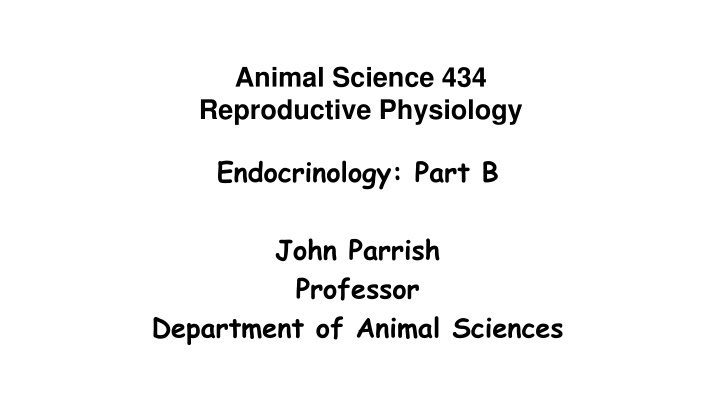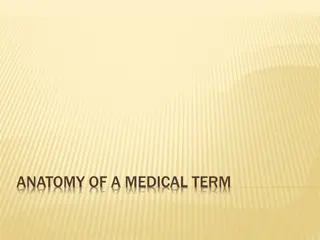
Hormone Action and Reproductive Physiology in Animal Science
Explore the intricate mechanisms of hormone action, focusing on reproductive physiology and endocrinology in animal science. Dive into the detailed processes involving protein hormones, cAMP second messengers, and the interaction with various cellular components to understand their role in reproductive functions.
Download Presentation

Please find below an Image/Link to download the presentation.
The content on the website is provided AS IS for your information and personal use only. It may not be sold, licensed, or shared on other websites without obtaining consent from the author. If you encounter any issues during the download, it is possible that the publisher has removed the file from their server.
You are allowed to download the files provided on this website for personal or commercial use, subject to the condition that they are used lawfully. All files are the property of their respective owners.
The content on the website is provided AS IS for your information and personal use only. It may not be sold, licensed, or shared on other websites without obtaining consent from the author.
E N D
Presentation Transcript
Animal Science 434 Reproductive Physiology Endocrinology: Part B John Parrish Professor Department of Animal Sciences
Mechanism of Hormone Action Protein Hormones (cAMP second messenger) LH G Plasma Membrane Receptor Adenylate Cyclase R Protein Kinase A (PKA) S-ER C Steroid Synthesis Mitochondria Nucleus DNA Protein Synthesis (Enzymes) R-ER Protein Synthesis
Mechanism of Hormone Action Protein Hormones (cAMP second messenger) LH G Plasma Membrane Receptor Adenylate Cyclase cAMP ATP cAMP R R Protein Kinase A (PKA) S-ER C C Steroid Synthesis Mitochondria Nucleus DNA Protein Synthesis (Enzymes) R-ER Protein Synthesis
Mechanism of Hormone Action Protein Hormones (cAMP second messenger) LH G Plasma Membrane Receptor Adenylate Cyclase cAMP R ATP cAMP Protein Kinase A (PKA) S-ER Steroid Synthesis C (+ PO4) Mitochondria Histones Nucleus DNA Protein Synthesis (Enzymes) R-ER mRNA Protein Synthesis
Mechanism of Hormone Action Protein Hormones (cAMP second messenger) LH G Plasma Membrane Receptor Adenylate Cyclase cAMP Testosterone R ATP cAMP Protein Kinase A (PKA) S-ER Steroid Synthesis C (+ PO4) Mitochondria Cholesterol Pregnenolone Histones Cholesterol Nucleus DNA Protein Synthesis (Enzymes) R-ER mRNA Protein Synthesis
Mechanism of Hormone Action Protein Hormones (cAMP second messenger) LH G Plasma Membrane Receptor Adenylate Cyclase cAMP Testosterone R ATP cAMP Protein Kinase A (PKA) S-ER Steroid Synthesis C (+ PO4) Mitochondria Cholesterol Pregnenolone Histones Cholesterol Nucleus DNA Protein Synthesis (Enzymes) R-ER mRNA Protein Synthesis
cAMP Second Messenger Hormones Anterior Pituitary Hormones LH, FSH, Prolactin STH, ACTH, TSH Placental Hormones HCG, eCG
Protein Hormones (Ca2+ Second Messenger) GnRH Receptor Plasma Membrane PIP2 G-protein PLC Protein Kinase C R Ca2+ Secretory Granules Endoplasmic Reticulum Plasma Membrane
Protein Hormones (Ca2+ Second Messenger) GnRH Receptor Plasma Membrane PIP2 PIP2 G-protein PLC Protein Kinase C R Ca2+ Secretory Granules Endoplasmic Reticulum Plasma Membrane
Protein Hormones (Ca2+ Second Messenger) GnRH Receptor Plasma Membrane DAG PIP2 PIP2 G-protein PLC Protein Kinase C IP3 Ca2+ R R Ca2+ Secretory Granules Endoplasmic Reticulum Plasma Membrane
Protein Hormones (Ca2+ Second Messenger) Ca2+ GnRH Receptor Plasma Membrane DAG PIP2 PIP2 G-protein PLC Protein Kinase C IP3 Ca2+ R R Ca2+ Secretory Granules Endoplasmic Reticulum Plasma Membrane
Protein Hormones (Ca2+ Second Messenger) Ca2+ GnRH Receptor Plasma Membrane DAG PIP2 PIP2 G-protein PLC Protein Kinase C IP3 Ca2+ R R Ca2+ Secretory Granules Endoplasmic Reticulum Fusion Plasma Membrane LH
Calcium Second Messenger Hormones GnRH triggers release of LH in anterior pituitary Oxytocin triggers contractions of smooth muscle PGF2 triggers apoptosis of cell inhibition of progesterone synthesis
Steroid Hormone Action (Slow) Steroid (estrogen) Cell Membrane Diffusion? Change in Cell Physiology Cytoplasm Nucleus New Protein Receptor DNA mRNA R-ER Protein synthesis
Steroid Hormone Mechanism Estradiol Progesterone Testosterone, Dihydrotestosterone Cortisol
Steroid Hormone (Fast) (cAMP second messenger) Estradiol Ca2+ G Plasma Membrane Receptor Adenylate Cyclase cAMP R ATP cAMP Protein Kinase A (PKA) Ca2+ C (+ PO4) Smooth Muscle Contraction (Uterine Myometrial Cell) Histones Nucleus DNA Protein Synthesis (Enzymes) R-ER mRNA Protein Synthesis
Steroid Hormone (Fast) Not the classical mechanism of action of a steroid hormone Requires plasma membrane receptor Operates via protein kinase activation Estradiol smooth muscle contraction of uterus Progesterone inhibits ion channels and thereby smooth muscle contraction of uterus, multiple kinases maybe involved
Neuro-secretory Cells Hypothalamus Feedback Loops Releasing Hormones Polypeptides Portal Vein - Anterior Pituitary - Gonadotropins: FSH, LH Proteins Blood Stream Gonads Why only effects on target organs [ ] Receptor on Cell Surface Cyclic AMP inside cell Testosterone Estradiol Progesterone { Steroid Hormone Production Blood Stream Bound to Protein
Endocrine Feedback Loops Negative gonadal steriods Testosterone, Progesterone, Estradiol Protein hormones inhibin Positive Gonadal steroids estradiol
Chapter 5 of Textbook (Senger, 2012) Contains more than covered here Responsible for all material in book Also Handout 4 (found in lecture outline)



